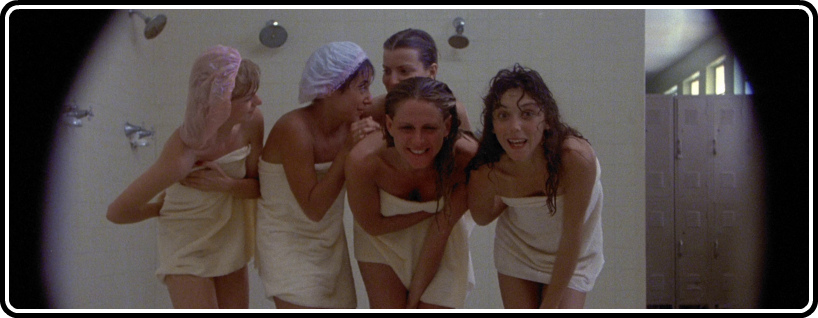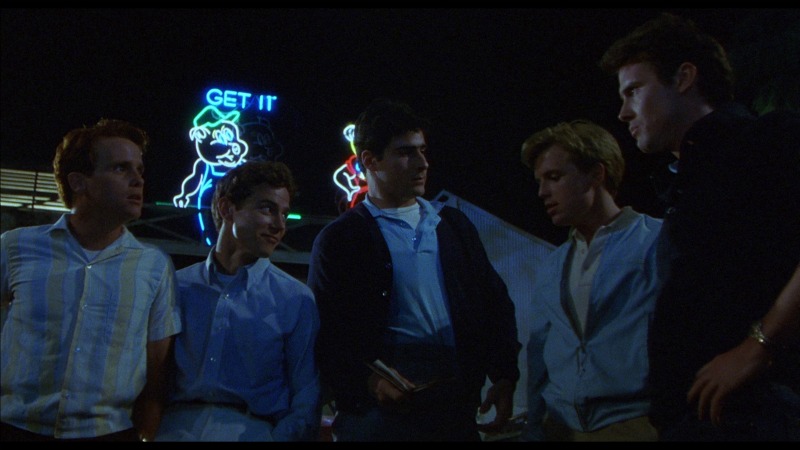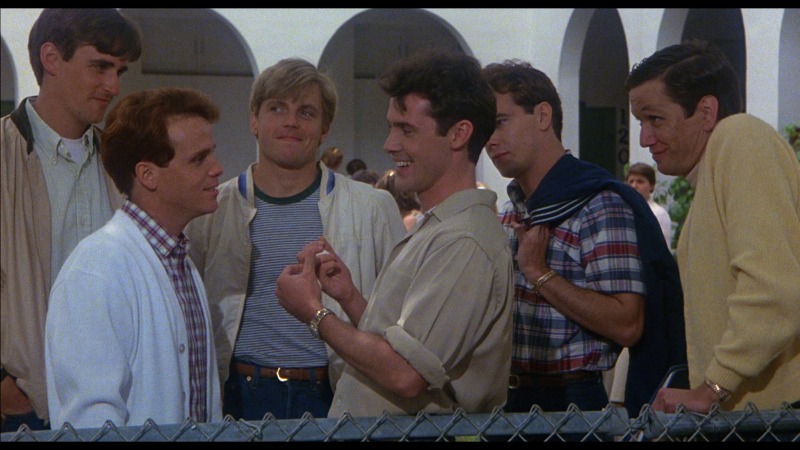
I’m not going to mount the campaign to reclaim Porky’s as some misunderstood classic of world cinema, but I will say that the 1982 Canadian blockbuster deserves mention alongside films like Rocky and Saturday Night Fever as being a great deal more nuanced and interesting than its reputation would suggest. Sure, it’s still very much about a group of high schoolers in a fictional Florida town circa 1954, looking to get their rocks off however they can, but the actors play their roles so far to the hilt, and writer/director/producer Bob Clark aligns his worldview so purposefully outside of the white mainstream, that I suspect on many levels he’s offering these boys up more as subjects of mockery and amusement than identification.
The film begins, after all, with its most laughable character – Edward “Pee Wee” Morris (Dan Monahan) awakens one morning in a state of excitement all too familiar to young men. As his mother enters to wake him, he dives to hide it, causing no small amount of discomfort. The moment his mother exits, he whips out a ruler to ascertain his endowment. He scurries about the school like a rodent hunting for scraps of food, only with goals a little further removed from the base of Maslow’s hierarchy of needs. He will be rebutted and demeaned at every turn for the remainder of the film, right up until the end. In fact, the more focused on sex or violence a character is in this film, the worse they will fare. The only guy who really comes away looking good is Brian Schwartz, a Jewish kid who’s picked on until he demonstrates a cunning mind and a trained body. The gentiles, meanwhile, are left to desperately tangle with one another, ultimately deferring to him when it comes time to seek their ultimate revenge (on, naturally, the titular strip club owner who has a side business as a pimp).

But the film’s real moment of damnation comes when the kids aren’t present at all. The school’s self-appointed morality enforcer, the aptly-named Coach Balbricker, is meeting with the other coaches and the principal to discuss asking a group of boys to strip nude so that she can identify a penis she saw poking through a shower drain in the girl’s locker room (yes, it is still that kind of movie). Needless to say, the request is absurd, and the coaches are having quite a good time at her expense, and finally the principal can’t take it any longer, either, and he begins cackling madly at the insanity of it all. Amidst this scene – two college-age men, two middle-age men, and one middle-age woman discussing the ins and outs of hunting down an offending student based only on his penis, with varying degrees of seriousness of intent – Clark cuts to a shot of a framed picture of then-President Dwight D. Eisenhower, the kind that might be found in any room in any American school at the time.
Altogether, the film seems to be a sharp rebuke of the then-building notion that things were just better – cleaner, more polite, better-mannered, and more principled – in the 1950s, a belief sadly clung to still today. Clark insists otherwise, recalling in the commentary track that all he and his friends wanted to talk about was sex and sports, only one of which they were terribly successful in pursuing. The resulting film, the stories for which were gathered from either his own memory or the firsthand accounts of his friends, is stocked to the brim with sexism, racism, violence, theft, vandalism, and any other manner of ill behavior not quite so formally condemned. As a result, Porky’s itself may be easily accused of adopting the same attitudes itself, were one eager to ignore that very important thing we call context, the atmosphere in which certain things are presented. As I stated at the top, I’m not about to nominate Porky’s as a great film, but it is shockingly mature in expecting the audience can think for themselves and draw their own conclusions about the attitudes and actions on display. As Mick LaSalle said of The Wolf of Wall Street, “How can people see [the film], loathe the central character — and then say the movie glorifies him? You’re not the only smart person out there.”

If one wishes to take the plunge, the new (Region B locked) Arrow Films Blu-ray offers up a stupendous transfer and a selection of decent supplements to go along with it. It’s not exactly the most aesthetically adventurous film in the company’s considerable catalogue, but it’s sharp, crisp, boasts a natural celluloid-esque texture, strongly-defined colors (the outdoor daylight scenes and the neon lights of Porky’s really pop), and decent contrast. Some shots fare worse than others, likely due to the source, but by and large I have no complaints here.
The only real special feature of note is the commentary track with Bob Clark, recorded in 2006 (he died the following year) and ported over for this release. He’s pretty up front about the film’s reputation, even if he scolds critics for not really seeing the subversion and honesty with which he was working. Then again, the film was a huge success, so what does he care if not everyone loves it. He has an excellent recollection of the details of production, from trying to scrounge together the relatively modest budget they sought to making the most of it when they got there, and especially the value of preparation. Great track.

The other two supplements – a brief 15-minute making-of that mostly recounts information available on the commentary, and a 13-minute interview with Mr. Skin about the film’s use of nudity – aren’t really of much interest. The former is self-explanatory, while the latter…well, hell, maybe that one needs no explanation either. One of life’s truisms is that it’s almost always interesting to hear someone discuss something about which they are passionate. Mr. Skin is the exception to this rule.
I had never seen Porky’s prior to receiving this disc, and I have to say I was surprised just how genuinely good the film actually is. So much of the genuine honesty that Clark brought to A Christmas Story (which he co-wrote and directed) is present here, and while it’s not hard to see why one runs for twenty-four hours as family programming every year and the other has been scorned since its release, I don’t think the two are really all that far apart, cinematically speaking. Both are fictionalized renderings of their respective authors lives, both undercut 1980s nostalgia for the years surrounding World War II, and both have a sort of episodic structure with an overarching story to tie it all together. One just has girls showering in a locker room. And that is no way to win critical approval in America.




![Bergman Island (The Criterion Collection) [Blu-ray]](https://criterioncast.com/wp-content/uploads/2022/11/bergman-island-the-criterion-collection-blu-ray-400x496.jpg)
![This Is Not a Burial, It’s a Resurrection (The Criterion Collection) [Blu-ray]](https://criterioncast.com/wp-content/uploads/2022/11/this-is-not-a-burial-its-a-resurrection-the-criterion-collection-blu-ray-400x496.jpg)
![Lars von Trier's Europe Trilogy (The Criterion Collection) [The Element of Crime/Epidemic/Europa] [Blu-ray]](https://criterioncast.com/wp-content/uploads/2022/11/lars-von-triers-europe-trilogy-the-criterion-collection-the-element-of-400x496.jpg)
![Imitation of Life (The Criterion Collection) [Blu-ray]](https://criterioncast.com/wp-content/uploads/2022/11/imitation-of-life-the-criterion-collection-blu-ray-400x496.jpg)
![The Adventures of Baron Munchausen (The Criterion Collection) [4K UHD]](https://criterioncast.com/wp-content/uploads/2022/11/the-adventures-of-baron-munchausen-the-criterion-collection-4k-uhd-400x496.jpg)
![Cooley High [Criterion Collection] [Blu-ray] [1975]](https://criterioncast.com/wp-content/uploads/2022/11/cooley-high-criterion-collection-blu-ray-1975-400x496.jpg)